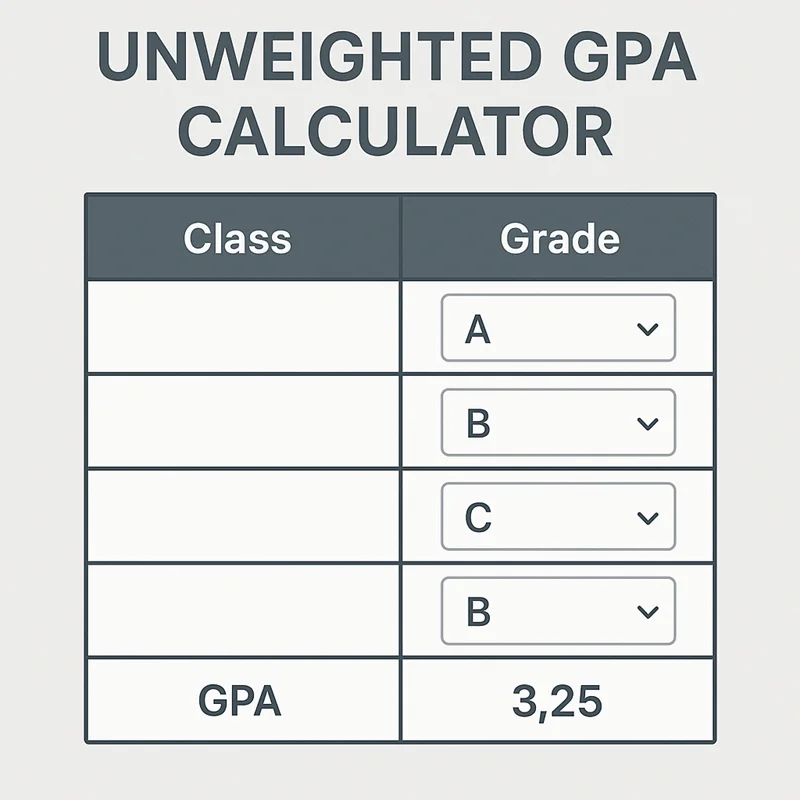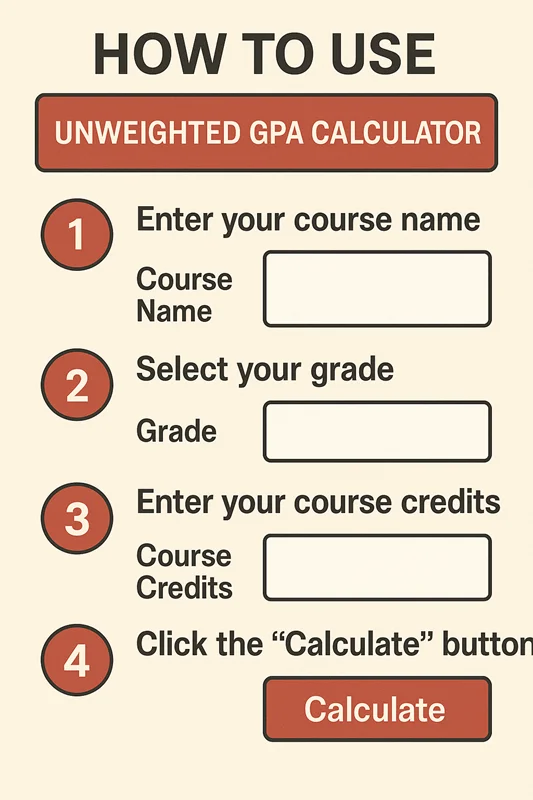Understanding your academic performance is crucial for high school success and college preparation. An unweighted GPA calculator simplifies this process by converting your letter grades into a standardized 4.0 GPA scale. This essential tool helps students, parents, and academic counselors track academic progress without the complexity of weighted grades from honors or AP classes.
Whether you’re planning for college applications, monitoring your academic standing, or simply want to understand where you stand academically, this comprehensive guide will walk you through everything you need to know about unweighted GPA calculation.
An unweighted GPA is your grade point average calculated on a standard 4.0 scale, where all classes are treated equally regardless of difficulty level. Unlike weighted GPAs, which give extra points for advanced courses, unweighted GPA provides a straightforward measure of your academic performance.
In the unweighted system:
This means that an “A” in regular English carries the same weight as an “A” in AP Biology. The unweighted GPA focuses purely on your letter grades without considering course difficulty, making it easier to understand and calculate.
Key Difference: While a weighted GPA might give you 5.0 points for an “A” in an AP class, an unweighted GPA will only count it as 4.0 points, just like any other “A” grade.
Using an unweighted GPA calculator is straightforward and saves you time on manual calculations. Here’s how to get your results:
Step 1: Gather Your Information Collect your report card or transcript with all your letter grades and the number of credit hours (or units) for each class.
Step 2: Input Your Data Enter each course’s letter grade and corresponding credit hours into the calculator. Most classes are worth 1 credit hour, but some courses like lab sciences might be worth more.
Step 3: Add All Courses Continue adding courses until you’ve entered all the classes you want included in your GPA calculation.
Step 4: Calculate Click the “Calculate GPA” button to instantly see your unweighted GPA on the 4.0 scale.
Step 5: Review Results The calculator will display your cumulative unweighted GPA, making it easy to understand your overall academic performance.

| Letter Grade | Grade Point | Percentage Range |
| A+ | 4.0 | 97-100% |
| A | 4.0 | 93-96% |
| A- | 3.7 | 90-92% |
| B+ | 3.3 | 87-89% |
| B | 3.0 | 83-86% |
| B- | 2.7 | 80-82% |
| C+ | 2.3 | 77-79% |
| C | 2.0 | 73-76% |
| C- | 1.7 | 70-72% |
| D+ | 1.3 | 67-69% |
| D | 1.0 | 65-66% |
| F | 0.0 | Below 65% |
| Aspect | Unweighted GPA | Weighted GPA |
|---|---|---|
| Scale | 4.0 maximum | Often 5.0+ maximum |
| Course Treatment | All classes equal | Advanced classes get bonus points |
| Calculation | Standard 4.0 scale | Varies by school system |
| College Use | Widely accepted | Requires recalculation |
| Advantage | Simple, universal | Rewards academic rigor |
| Best For | General comparison | Showing course difficulty |

A good unweighted GPA typically falls between 3.0-4.0. For college applications, a 3.5+ is generally competitive, while top-tier universities often look for 3.8+ GPAs. However, "good" depends on your goals and the schools you're targeting.
Multiply each letter grade's point value by the course's credit hours, add all quality points together, then divide by total credit hours. Use the standard 4.0 scale where A=4.0, B=3.0, C=2.0, D=1.0, F=0.0.
Yes, unweighted GPA is very important for college admissions. It provides admissions officers with a standardized way to compare students from different schools and academic programs, regardless of their specific weighting systems.
You cannot directly convert weighted to unweighted GPA through a simple formula. You must recalculate using your original letter grades and the standard 4.0 scale, treating all courses equally regardless of their difficulty level.
Tracking your unweighted GPA is essential for academic success and future planning. This standard GPA calculator provides a clear, unbiased view of your academic performance that colleges and employers can easily understand and compare.
Regular GPA monitoring helps you identify areas for improvement, set realistic academic goals, and stay on track for your future aspirations. Whether you’re aiming for honor roll, college admission, or scholarship opportunities, understanding your unweighted GPA puts you in control of your academic destiny.
Bookmark this unweighted GPA calculator and use it regularly to stay informed about your academic progress. Remember, every grade matters, and consistent effort leads to steady improvement. Your GPA is more than just a number—it’s a reflection of your dedication and a stepping stone to your future success.
Take charge of your academic journey today by calculating your unweighted GPA and setting goals for continuous improvement!